Mary B. Cobb: A Kentucky Portraitist
By Angelique Perez
Michael N. Harreld Intern, University of Louisville
About |
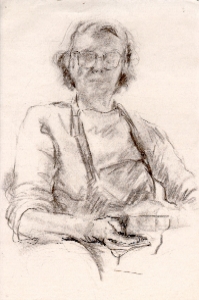 The Filson acquired the collection in 2003 from Mary Cobb, who says that she is happy to know that her artwork will
have a “safe home at The Filson.” I began working with the collection this year as a student intern from the University
of Louisville’s liberal studies department. I have been busy organizing and cataloging the collection in a manner
that will be useful to researchers in a wide range of areas. Overall the collection materials reveal Cobb as an insightful
and adventurous individual whose artistic talents and achievements have earned her a place among the ranks of Kentucky’s most
distinguished portrait artists.
The Filson acquired the collection in 2003 from Mary Cobb, who says that she is happy to know that her artwork will
have a “safe home at The Filson.” I began working with the collection this year as a student intern from the University
of Louisville’s liberal studies department. I have been busy organizing and cataloging the collection in a manner
that will be useful to researchers in a wide range of areas. Overall the collection materials reveal Cobb as an insightful
and adventurous individual whose artistic talents and achievements have earned her a place among the ranks of Kentucky’s most
distinguished portrait artists.
Mary Cobb studied painting and drawing at Sarah Lawrence College before beginning her dynamic career by working as a
courtroom artist for WHAS-TV. She covered courtroom scenes in Kentucky and beyond between 1971 and 1976, practicing her
skill in representing the human form, a skill that became essential as her career in portraiture developed. Cobb was attracted
to portrait making because of her love for people and credits her late husband, Paul Stewart Cobb, with offering her the
support that she needed to pursue her passion. Mrs. Cobb recalls that she “always 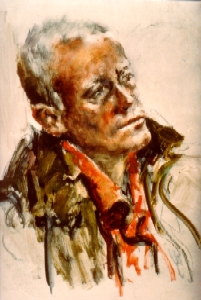 loved to draw and paint people, and found
that likenesses came easily” to her. Cobb also remembers that the services of portrait artists were in demand and that she hoped
she could earn a living in the field. She describes clipping portraits of her daughters on a makeshift clothesline during the annual
St. James Court Art Show in Louisville to advertise her portrait-making services. These efforts paid off as she began receiving
phone calls from interested customers, thus beginning her long and successful career as a portrait artist. Cobb initially chose
pastels as the medium for her portraits but gradually made a transition to oil paints under the advice of renowned artists Aaron
Schikler and Raymond Kinstler. Mrs. Cobb has worked as a portraitist for over 40 years, and her expert technique and unique style have
earned her an excellent reputation in the field. In the course of her career, she has painted some of Kentucky’s most influential
residents including Barry Bingham, Mitch McConnell and Archbishop Thomas Kelly. The collection illuminates Cobb’s portrait-painting
process and technique by featuring many examples of her portraits, as well as photographs of subjects, and of paintings in various
stages of completion.
loved to draw and paint people, and found
that likenesses came easily” to her. Cobb also remembers that the services of portrait artists were in demand and that she hoped
she could earn a living in the field. She describes clipping portraits of her daughters on a makeshift clothesline during the annual
St. James Court Art Show in Louisville to advertise her portrait-making services. These efforts paid off as she began receiving
phone calls from interested customers, thus beginning her long and successful career as a portrait artist. Cobb initially chose
pastels as the medium for her portraits but gradually made a transition to oil paints under the advice of renowned artists Aaron
Schikler and Raymond Kinstler. Mrs. Cobb has worked as a portraitist for over 40 years, and her expert technique and unique style have
earned her an excellent reputation in the field. In the course of her career, she has painted some of Kentucky’s most influential
residents including Barry Bingham, Mitch McConnell and Archbishop Thomas Kelly. The collection illuminates Cobb’s portrait-painting
process and technique by featuring many examples of her portraits, as well as photographs of subjects, and of paintings in various
stages of completion.
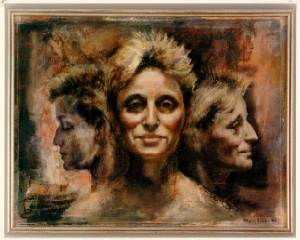 In addition to her commissioned work, Mary Cobb has approached artistic projects and subjects that reveal her deep commitment to people,
social action and advocacy. One of her most inspiring projects originated during her work with the St. John’s Center for the Homeless in the 1980s.
Cobb began working as a volunteer at St. John’s in 1985 and conceived the idea of painting portraits as a way to communicate with and understand
the Center residents. Cobb states, “Working from life, art becomes the medium for communication. Natural defenses and barriers transform into
mutual trust as the image of the subject evolves. These are magical moments.” Mrs. Cobb recalls being moved by the depth of experience that she saw
etched into the faces of the men at the Center and hoping to record some of their experience in her paintings. She set up a table, giving residents the opportunity
to sit for portraits made with pencil, pastels or oils. The high degree of respect
In addition to her commissioned work, Mary Cobb has approached artistic projects and subjects that reveal her deep commitment to people,
social action and advocacy. One of her most inspiring projects originated during her work with the St. John’s Center for the Homeless in the 1980s.
Cobb began working as a volunteer at St. John’s in 1985 and conceived the idea of painting portraits as a way to communicate with and understand
the Center residents. Cobb states, “Working from life, art becomes the medium for communication. Natural defenses and barriers transform into
mutual trust as the image of the subject evolves. These are magical moments.” Mrs. Cobb recalls being moved by the depth of experience that she saw
etched into the faces of the men at the Center and hoping to record some of their experience in her paintings. She set up a table, giving residents the opportunity
to sit for portraits made with pencil, pastels or oils. The high degree of respect 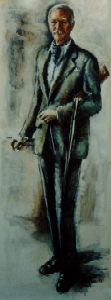 that she afforded these men is palpable in her work, as she depicts
them with dignity and as complex individuals. The tradition of portrait painting reflects a keen concentration on society’s most important members
and events. This history is evident in the many grand portraits that cover The Filson’s walls. While Cobb’s work always demonstrates her respect
for this historical tradition, she also extends the conventional boundaries of the genre by affording more marginalized and overlooked members of
society what art historians often term as the ultimate form of appreciation. Many of the portraits that she painted at St. John’s still grace the Center’s
walls, and her sketches became the basis for a wall mural design, completed in 2003. The Filson now houses several examples of Cobb’s St. John’s portraiture
as well as information about the center itself.
that she afforded these men is palpable in her work, as she depicts
them with dignity and as complex individuals. The tradition of portrait painting reflects a keen concentration on society’s most important members
and events. This history is evident in the many grand portraits that cover The Filson’s walls. While Cobb’s work always demonstrates her respect
for this historical tradition, she also extends the conventional boundaries of the genre by affording more marginalized and overlooked members of
society what art historians often term as the ultimate form of appreciation. Many of the portraits that she painted at St. John’s still grace the Center’s
walls, and her sketches became the basis for a wall mural design, completed in 2003. The Filson now houses several examples of Cobb’s St. John’s portraiture
as well as information about the center itself.
Mrs. Cobb continued to use her painting as a means of building rapport when she traveled to Ghana in 1988 under the auspices of St. Francis
in the Fields Episcopal Church. During her journey she completed drawings and paintings that highlight the experiences of the Ghanaian people in
the village of Bolgatanga, where she resided during her six-week stay. Cobb’s Ghanaian works continue to reflect her deep appreciation for people and
candidly depict everyday situations, poses and bodily gestures. The Cobb collection contains several examples of her Ghanaian works and includes
information 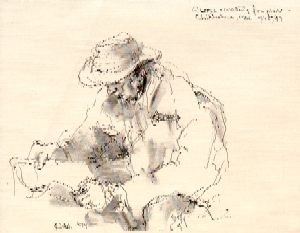 about the country itself and her experiences there. A letter from a Ghanaian friend reveals that her time in Ghana
continued to have an impact on her long after she had left the country. In addition to Ghana, Mrs. Cobb’s interest in people and places led
her to explore countries such as Morocco, Italy and Scotland. She documented her travels in diaries that include written insights and sketches
of the people and places that she encountered, and these diaries reveal the artist’s adventurous and inquisitive nature.
about the country itself and her experiences there. A letter from a Ghanaian friend reveals that her time in Ghana
continued to have an impact on her long after she had left the country. In addition to Ghana, Mrs. Cobb’s interest in people and places led
her to explore countries such as Morocco, Italy and Scotland. She documented her travels in diaries that include written insights and sketches
of the people and places that she encountered, and these diaries reveal the artist’s adventurous and inquisitive nature.
Mrs. Cobb’s focus on average people doing average things continues in her “Waiting” series. The “Waiting” series is comprised of beautiful drawings and sketches,
completed mainly in pencil or in ink. This series concentrates on the common occurrence of waiting at places such as the bus stop, the airport or in
doctor’s offices. In Cobb’s 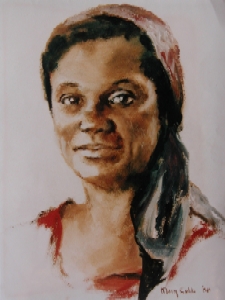 attention to the phenomenon of waiting, she captures a sense of kinetic energy within the people she draws. This
series accentuates Cobb’s ability to capture the defining lines of someone’s facial expression, or the essential lines of a pose or a movement. Mrs. Cobb
uses lines sparingly, and her marks are essential for the communication of her subjects, which is always her primary goal.
attention to the phenomenon of waiting, she captures a sense of kinetic energy within the people she draws. This
series accentuates Cobb’s ability to capture the defining lines of someone’s facial expression, or the essential lines of a pose or a movement. Mrs. Cobb
uses lines sparingly, and her marks are essential for the communication of her subjects, which is always her primary goal.
The Cobb collection contains a wealth of information related to Mary Cobb’s life and work and is useful to researchers in a variety of areas. Researchers with an interest in the local arts or in portraiture will find the collection especially useful. Cobb’s collaborative projects with Meg Higgins, Anne Stewart and Judy Chicago are a research tool for those investigating women in the arts or women’s issues more broadly. These collaborative projects, “Hot Flash Fan” and “Facing 50,” center around the themes of women and aging, exploring and defying the often-negative stereotypes associated with women’s aging bodies. Other aspects of the collection are of interest to researchers investigating people and places of Louisville, homelessness or poverty in Louisville, courtroom art, and travel drawing.
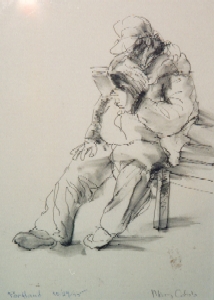 Mary Cobb is an accomplished and dynamic artist who has made it her career mission to understand and document a wide range of human
experiences. Her artistic success flows from her ability to communicate with and appreciate people. Mrs. Cobb states, “That each of us is unique
is probably why I find drawing or painting the human form a constant challenge. Searching for and responding to that ‘kingdom within’ is what it’s all
about for me – whether best expressed through the tilt of the head, the expression in the eyes, the curve of a wrist, communication has to be felt or it’s
unsuccessful.” Overall, the Mary Cobb Collection illuminates Mrs. Cobb’s mission of discovery and reveals her unique ability to poignantly depict the “kingdom
within” for which she so ardently searched in all of her
subjects..
Mary Cobb is an accomplished and dynamic artist who has made it her career mission to understand and document a wide range of human
experiences. Her artistic success flows from her ability to communicate with and appreciate people. Mrs. Cobb states, “That each of us is unique
is probably why I find drawing or painting the human form a constant challenge. Searching for and responding to that ‘kingdom within’ is what it’s all
about for me – whether best expressed through the tilt of the head, the expression in the eyes, the curve of a wrist, communication has to be felt or it’s
unsuccessful.” Overall, the Mary Cobb Collection illuminates Mrs. Cobb’s mission of discovery and reveals her unique ability to poignantly depict the “kingdom
within” for which she so ardently searched in all of her
subjects..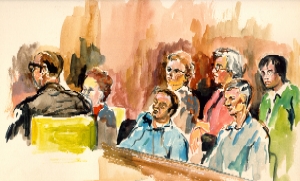
The Filson Historical Society
1310 South Third Street - Louisville, KY
40208
Phone: (502) 635-5083 Fax: (502) 635-5086
Hours
The Ferguson Mansion and Office
Monday - Friday: 9 am. - 5 pm.
Saturday and Sunday closed
Library
Monday - Friday: 9 am. - 5 pm.
Saturday: 9 am. - 12 noon
